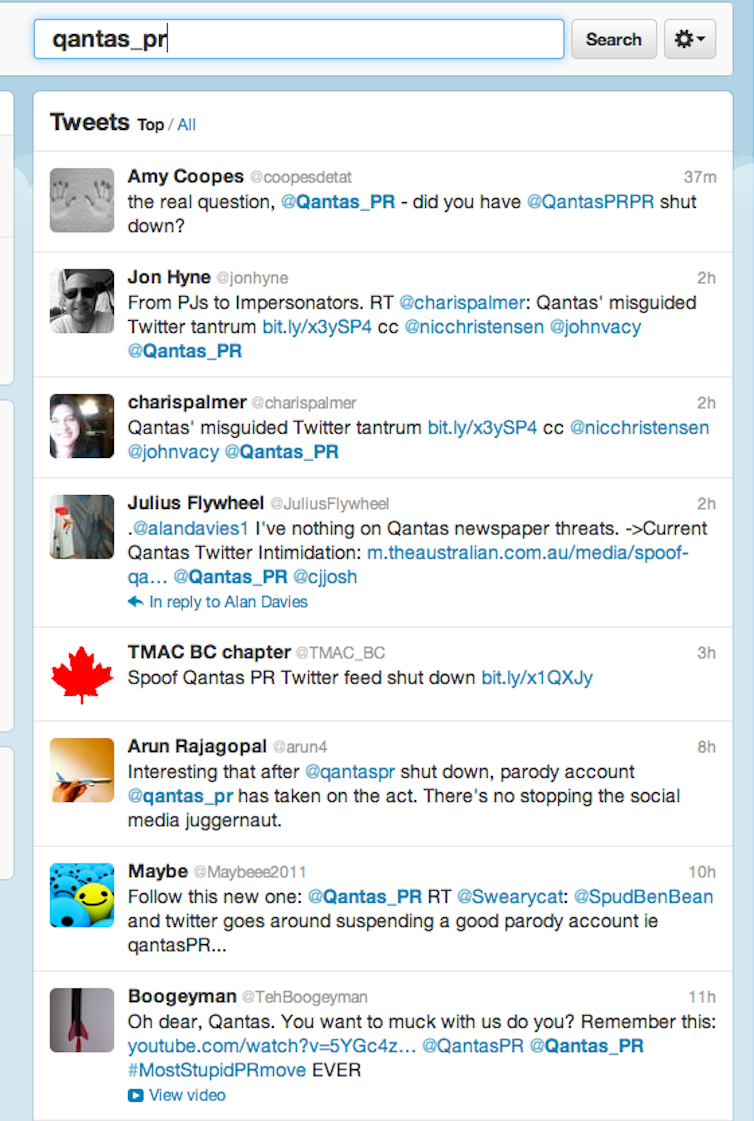

For major brands, the road to social media infamy is paved with what seemed like good ideas at the time.
Just this week, Qantas succeeded in having Twitter suspend the well-known spoof account, @QantasPR, claiming users would mistake it for the real thing (Shane Warne did, but that’s not exactly saying much.)
It is the second time its approach to Twitter has hit turbulence. A few months ago, Qantas decided to run a Twitter competition inviting people to share their fantasies of a luxury holiday. Unfortunately for them, the competition hashtag, #qantasluxury, became a lightning-rod for complaints about poor service, unreliable connections, and management’s do-or-die strategy to move major operations offshore.
Not to be outdone, McDonald’s set up its own promo hashtag, #McDstories, asking its customers to share their fondest memories of visiting the fast-food chain. Little did they expect, apparently, the litany of complaints about dodgy service, poor food, and serious health problems which eventuated.
It’s difficult to understand how the well-paid PR advisors behind such disasters could not have seen them coming. Did Qantas, for example, really expect that the negative press resulting from the months of its bitter and belligerent fight against its own workforce, and from its declared intention to move as much as possible of the airline to Asia, would not lead to a significant public backlash?
Perhaps these people really do buy their own PR hype – perhaps they truly, honestly believe that Coca Cola indeed “is it”, that McDonald’s diners are actually “lovin’ it”, that Qantas will always remain the “Spirit of Australia”, wherever it may be based. If so, the social media response may serve as a useful reality check: customers aren’t the sheep they may appear to be.
The problem for the flacks is that conventional PR has long focussed on a broadcast mode of message dissemination: they were able to repeat their messages unchallenged, ad infinitum, in print, on radio and TV, through outdoor advertising. However quickly we’d all reach for our remotes to mute the commercials, enough of them would seep through to gradually create a certain brand image.
In a social media environment, though, brands are conversations (to echo the Cluetrain Manifesto) – it’s no longer possible just to shout at customers, because now they can answer back, and are sometimes able to do so at a volume which well surpasses that of the original message itself. Many Twitter users would have found out about the #qantasluxury or #McDstories campaigns not because of the companies’ own promotional efforts, but only because of the negative publicity they resulted in.
And it’s how these brands respond to such negative publicity that reflects most clearly on their corporate integrity. When Westpac lifted its interest rates the other day, out of step with the Reserve Bank of Australia, this resulted in a fair number of negative, sometimes angry, comments on its official Facebook page. The bank’s initial response was simply to delete a number of them – the digital equivalent of sticking your fingers in your ears, going “La-la-la, I can’t hear you.”
(A Westpac spokesman told The Conversation that the comments which were deleted had been “racist and offensive” and contravened its social media policies, and pointed to substantial number of negative comments which remain on its Facebook page. Other users did report that even more benign comments were removed, however.)
Choosing Twitter as the platform for their promo activities, McDonald’s and Qantas didn’t have access to similar forms of censorship; once unleashed, there was nothing they could do to stop the barrage of criticism.
However much Qantas might dislike being the butt of @QantasPR’s jokes, such attempts at censorship will achieve precisely nothing, other than to further tarnish the company’s image.

Nicely illustrating what’s called the “Streisand effect” of attempting to suppress the unsuppressable, new accounts @Qantas_PR and @QantasPRPR have already popped up in place of the suspended one (not to mention @AlanJoyceCEO, @Alan_Joyce_CEO, and @AlanJoyceNot – all fakes, too). Given the real Qantas PR’s track record, this may turn into an interesting cat-and-mouse chase – but while entertaining to onlookers, none of it will benefit the brand.
The simple lesson which PR managers must learn is this: out there in the real world, there are people who don’t much like your brand – who’ll even make fun of it at times. Get used to it. You can’t make them go away; you can’t even shout louder than them any more. You certainly can’t censor what they have to say; to do so will only reinforce the negative perceptions of your brand that people already have.
Westpac, Qantas, all of you: rather than wishing away your detractors, or wasting your time with silly promos, you might like to spend some time considering why so many people criticise you, own up to your problems, and address them. Your best strategy is to surprise your critics by taking them seriously – time for a little honesty and maturity in engaging with your customers.
Axel Bruns, Associate Professor, Creative Industries, Queensland University of Technology
https://theconversation.com/how-not-to-use-twitter-lessons-from-qantas-and-westpac-5342